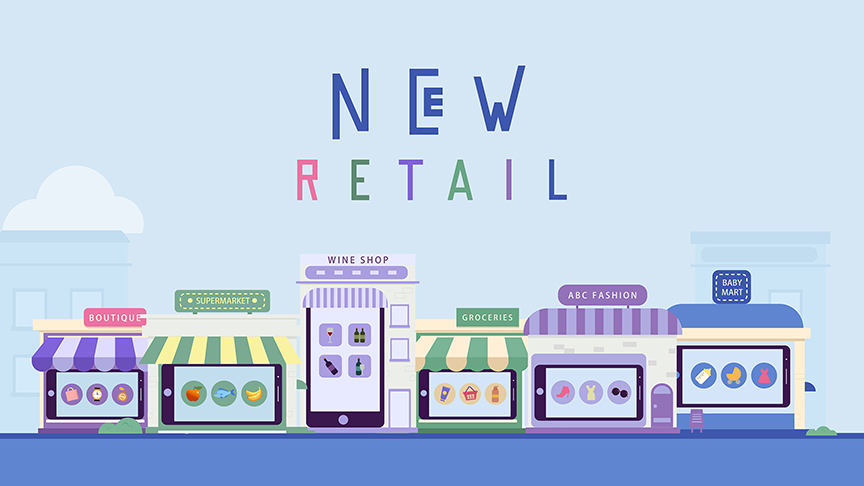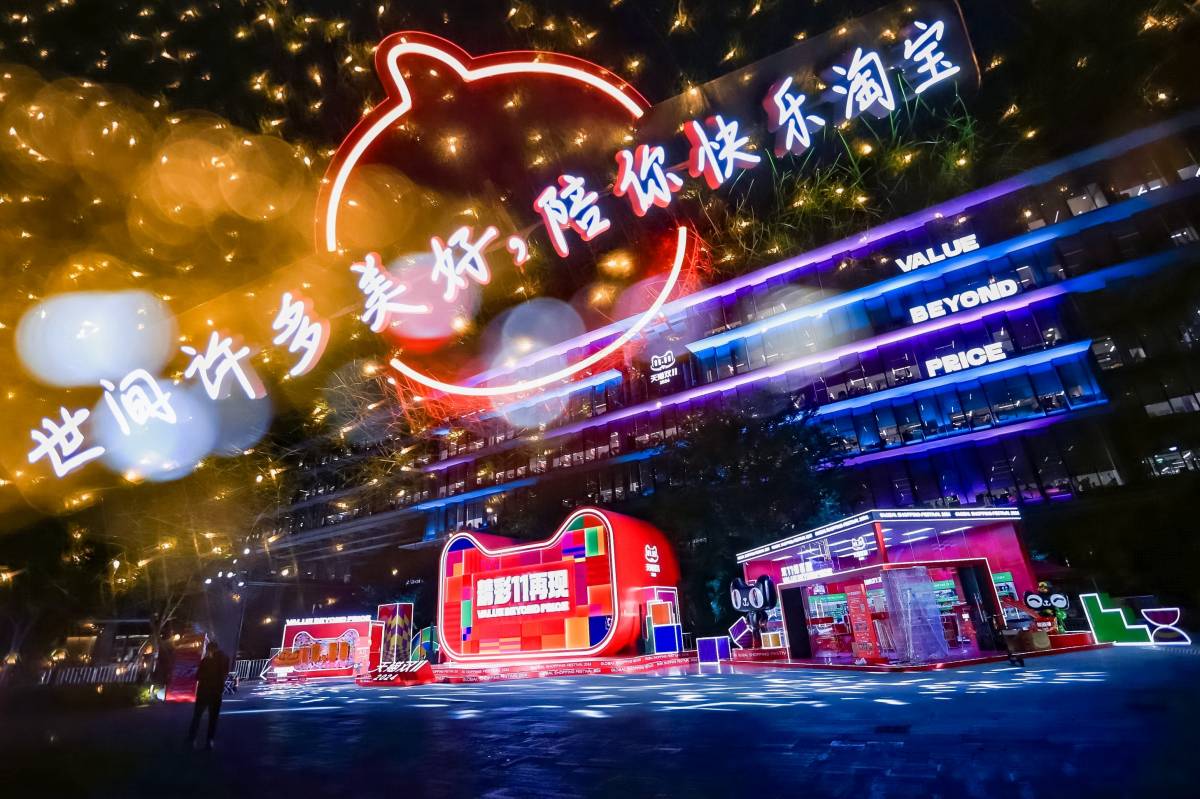
U.S. retail is at a crossroads.
Despite a 4.2% rise in 2017 over the previous year, retail growth is lumpy and clearly not firing on all cylinders. Nearly every week brings news of bankruptcies or downsizings. Online sales, meanwhile, have been climbing, underpinning the sector’s overall growth.
In the overall picture, brands and retailers are trying to decide whether e-commerce is friend or foe. On one hand, e-commerce is denting traditional brick-and-mortar business, but on the other, you’ll have a hard time finding a company whose future growth strategy doesn’t rest on developing its online channels.
Watch: Alibaba’s New Retail Explained
New Retail Moves to the Forefront
There’s no such quandary 8,000 miles away in China, where the “either-or” retail equation is being pushed aside in favor of a model, called “New Retail,” melding the best of both the in-shop and online experiences.
Leading the way is Alibaba, which operates the country’s largest e-commerce platforms and has more than half a billion consumers shopping on its marketplaces. Online sales penetration in China is the highest in the world, but brick-and-mortar retail still accounts for more than 80% of total retail sales.
Realizing that the future of retail will not be a question of online vs. offline, Alibaba founder Jack Ma unveiled the New Retail concept two years ago. Though still young, it’s already a game-changer for many different types of retail experiences in China.
‘New Retail’ is not just supermarkets and convenience stores. It’s much bigger and more-sweeping than this,” wrote Jeffrey Towson, a Peking University professor and private equity investor who closely follows the development of China’s retail sector, in his blogearlier this year. “New Retail’ is a bold extension of Alibaba’s strategy of pure digital competition into the physical world. And it hinges on the strange economics of participation…New Retail’ means a massive expansion in their brands and merchants and in the participation and activities of their consumers.”
Turning Supermarket Hell into Freshippo/Hema
Who actually enjoys trundling a shopping cart up and down the aisles, searching the shelves, settling for what the store has in stock, standing in line to pay and schlepping the heavy bags back home?
Shoppers have none of those hassles at Alibaba’sFreshippo (also known as Hema)supermarkets, which the company created to incubate new retail innovations that could be applied to the broader industry. At first glance, Freshippo looks like most other supermarkets: It sells groceries, fruits and vegetables, and fresh seafood. But this is not your typical grocery store.
“I walked into Hema [Freshippo] not knowing what to expect–digital extravaganza or shopping made simple. It turned out to be something in-between. I came to see the QR code as the great equalizer,” said Steve Stine, whose Inside Asia website produced a podcastafter a visit to a Freshippo store in Shanghai.”The entire experience was quick, efficient and painless.”
Shopping at Freshippo is a smartphone-powered experience—you can do it from home or in the store. When you’re in the store, you’re able to scan a bar code with your phone to get product information. Payment is also cashless, done through the Alipay platform embedded in the Freshippo app.
For some, Freshippo’s “hook” is the ability to choose your own fresh seafood and decide whether you want it to go home with you—raw or cooked—or have it prepared to eat in-store.
Watch: Take a tour of Freshippo supermarket and experience New Retail
For those who live within three kilometers of the market, Freshippo’s ability to deliver in as fast as 30 minutes is its best asset. Each store serves as its own warehouse and logistics center that collects, fulfills and delivers customer orders as fast as they come in, online or offline.
Taking the Pain Out of Car Shopping
If you’ve ever bought a new car, you’ll appreciate what New Retail is doing for the experience in China.
Instead of visiting one dealer at a time and spending hours perusing mega-lots and facing pressure from a salesman, Alibaba is rolling out “auto vending machines.” It recently launched its first with Ford in the bustling southern city of Guangzhou and plans more in the near-future.
The Ford auto vending machine lets customers browse makes and models inside their app, choose one they want to test drive, pick it up from an unmanned vending machine and drive it for up to three days. After experiencing the car in a no-pressure situation, they can make an appointment to visit a dealer when they’re ready to buy.
“The technology advancements provided by the Alibaba platform are…giving brands new options to totally rethink how they operate, how they engage with the consumer,” said Jason Ding, a Bain & Co. partner in Beijing, who co-authored a recent report on New Retail with AliResearch.
Watch: Test drive Tmall’s new car vending machine
Neighborhood Convenience Stores Get More Convenient
The mom-and-pop convenience store is a sector long in need of a New Retail upgrade. The lifeblood of many communities, some six million of the drinks-smokes-and-snacks shops dot neighborhoods and street corners across China. Most are family-run businesses, with proprietors ordering by gut feel and when products run out.
Until Alibaba’sLing Shou Tongprogram came along, the model hadn’t been updated in several decades. Stores are modernized and brightened. They get updated signage.
But there’s a lot more going on under the hood. Alibaba custom-built an app to digitize the inventory management of each store. That lets proprietors know what they need to order, how much and when. It also tied these business into a central warehousing and logistics system.
Ling Shou Tong’s customer insights can make brands smarter. Snack company Mondelez, for example, filled a need for sweet-toothed customers by producing single-serving Oreo cookie sleeves that stores have strategically placed near the cash register.
Watch: Mom-and-pop convenience stores go high tech
Mall Rats of the World, Don’t Despair. Here Comes New Retail
And what about malls? While tumbleweeds can be seen blowing through the aisles in the U.S., Alibaba has begun pumping up China’s malls with a dose of New Retail. The way to customers’ hearts is to have what they want, in the size and color they want, when they want it. The reality of the mall-shopping experience is that you often find the right pants, but not the right size or color in stock.
New Retail in the mall means less of a chance that you’ll walk away empty-handed. Stores are equipped with “virtual shelves,” and if you don’t find your size or color in stock, you can still select the product you want on a screen, punch in your size, color and other specs, scan with your app, and have exactly what you want delivered directly to your home.
Thepowder roomof malls is also becoming a New Retail experience. Step into the ladies’ room, and while you’re waiting, check out the “magic mirror” on the wall to experiment, virtually, with new makeup colors. Like what you see? You can buy it from the vending machine.
Watch: Alibaba, Intime Partner to Build ‘Smart’ Ladies Rooms
More New Retail to Come for Sectors, Brands
Restaurants, like the nearly century-old Wu Fang Zhai, are candidates for a New Retail upgrade. Working with Alibaba’s local-services company, Koubei, proprietors digitized and modernized operations, letting customers order from their table via scannable QR codes and collect their orders from food “lockers” abutting the kitchen. Operations are now more-efficient than ever before – and the rice dumplings are just as good as they’ve ever been.
Watch: Century-Old Restaurant Gets a Koubei Makeover
And even on the brand level, New Retail can be a game-changer or provide an edge in China. Ask Mars, which leveraged Alibaba technology and customer insights to craft a new spicy Snickers bar just for the China market. And then, there’s Welden, the small handbag-maker that found virtual overnight success in a brand-new market via video live-streaming.
Watch: U.S. Entrepreneur Builds Brand in China from Her Living Room
Why Change Happens Faster in China’s Retail Sector
To understand why China’s retail sector is changing faster than elsewhere, you need to grasp Alibaba’s role as a marketplace operator. For nearly 19 years, it has built the backbone of China’s giant e-commerce machine, essentially creating a “move-in” environment for brands, as well as an engaging discovery and frictionless purchase process for shoppers.
As a marketplace operator, Alibaba offers a panoply of services to brands–advertising and marketing tools, payment systems, logistics and cloud computing, media and entertainment properties. Brands selling on its B2C platform, Tmall, build storefronts that look just like their own online stores, because the brands own the customer experience and relationship. They also own all of the related analytics.
All of that aims to help brands succeed. There’s zero competition with Alibaba, unlike in the U.S., where online retailers may directly butt heads with the brands selling on their platforms.
To Alibaba, success these days also means helping brands go omnichannel. An increasing number of brands are doing just that, tapping Alibaba’sNew Retail tools, erasing the lines between online and offline.
The key to New Retail is the mobile phone, which provides the critical connection between online and offline retail to consumers. Brands in China have an advantage here because they don’t need to convince consumers to download and use their apps. That’s because they know 500 million consumers already have the Tmall app.
The China retail sector is also not torn between propping up legacy business and trying something new. Its brick-and-mortar retail operations are less-developed than in the West.
“China is moving much faster than the West in this evolution because the Western retail model is built on legacy systems. China’s model is disruptive,” said Frank Lavin, CEO of ExportNow, a company which helps Western brands sell to China. “China does not have the legacy of malls and big-box stores like the West. China has no traditional retail model to defend.”
More on Alibaba’s New Retail




